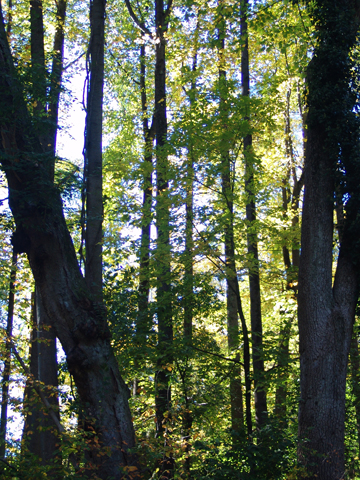ENTS explore the Crum Woods
Last May, Scott Wade, State Coordinator of the Champion Tree Program for Pennsylvania, gave a tour to our volunteers of some of the state champion trees in our region. At the time none of the trees at the Scott Arboretum had been measured to see if they qualified for the distinction of Champion Tree. Thus we made Scott promise to return to the Scott Arboretum to see what specimens he might find among our collections.
On January 30, he returned as promised with a colleague, Mike Dunn, to explore the hidden treasures in the Crum Woods. Read about their discoveries below as posted on Eastern Native Trees Society (ENTS) Google group.
As spring arrives in the Crum Woods, I encourage you to explore and see if you can find the specimens Scott found and some he may have missed. Anyone can submit a tree to the Champion Tree Program. Click here to learn more about the measuring technique used to document the trees.
Swarthmore College, Crum Creek Watershed Rucker
By Scott Wade and Mike Dunn
Today was an excellent day to spend in the woods. I finally met up with Mike Dunn, one of our newer ENTS members. Turns out that Mike and I went to the same elementary school and he lived down the street from me! Funny how that works out. Anyway, we met at the Springfield Mall and then drove over to the College. Swarthmore is an old Quaker liberal arts college just outside of Springfield PA., in Delaware Co. It is home to the Scott Arboretum and a few champion trees. Running along the back of the campus is the Crum Creek that empties into the Delaware River. Crum is Dutch for crooked. This creek has cut a steep gorge over the centuries and has provided an optimal site for trees to get tall. I was introduced to the area by the staff of the arboretum when they showed me a tulip poplar (previously reported) down in the woods along the creek. I was intrigued and vowed to return. It is the first tree listed.
We started off looking for the tulip that I could not get a height on when it was in leaf. After we measured it we decided to go for a Rucker index for the site. A Rucker index is an average height of the ten tallest species in a patch of forest.
Here is what we found:
The first number is the circumference at breast height in feet (CBH). The second number is the height in feet.
Tulip 16.5 x 153.0
Tulip 13.1 x 147.2
*Cherry about 6.0 in cbh x 111.9 (P. avium)
Pignut Hickory 7.1 x 133.9
Pignut Hickory 7.4 x 127.8
Bitternut Hickory 8.3 x 113.6
White Ash 9.2 x 134.2
Chestnut Oak twin x 118.3
*Sycamore about 7 x 132.9
*White Pine about 6 x 131.7
Hemlock 104.4
*Black Gum about 95′
American Beech 97.6
American Beech 112.4
Red Oak 15.1 x 130.1
Mockernut Hickory 7.8 x 115.4
*Trees with estimated girth were across the creek.
The top ten provide a Rucker of 127.5 Which is one of the biggest I have ever reported. It would have been a lot lower, but Mike found a monster red oak on the way out that we initially missed because we were looking for the big tulip!
Other species present but not measured:
Red and Silver Maples
Paulownia
Witch Hazel
Hornbeam
Dogwood
Spicebush
Rhodo max
Plenty of invasive including:
Japanese Knotweed
Japanese Barberry
English Ivy
Burning Bush
Norway Maples
among others.






Ted Patterson
Posted at 16:01h, 19 MarchGreat link to the Eastern Native Trees Society. I can get lost in the woods for hours at their website. Thanks.
Julie Vrooman
Posted at 21:59h, 23 MarchOn the Champion Tree site if looks like Scott has the american elm with the most points. (Does this make it the champion?) I presume this Is this the magnificent elm between the railroad tracks and the fraternities.
Scott Wade
Posted at 09:10h, 24 MarchThat is correct. The Elm by the tracks is the current Champion, as is the Kentucky Coffee tree near the tennis courts. Scott